Dry Skin Treatment: Simple Solutions for Soft and Hydrated Skin
Dry skin is a prevalent skin issue characterized by a lack of moisture, resulting in rough, itchy, and uncomfortable patches. It can affect anyone and is often caused by factors like genetics, aging, harsh weather, or excessive bathing. Managing this condition requires gentle care, hydration, and effective moisturizing routines to alleviate discomfort and restore skin health. We will discuss the following topics:
Causes of dry skin
Symptoms of dry skin
Consequences of dry skin
Treatment of dry skin
Tricks to avoid scratching a dry and itchy skin
Eczema
When to seek urgent medical care for dry skin
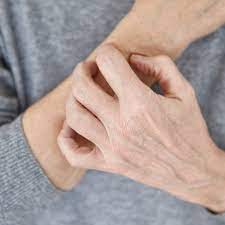
Causes of dry skin
This can arise from a multitude of factors, both external and internal. External factors encompass environmental conditions and lifestyle choices, while internal factors may involve genetics or underlying medical conditions. Here’s a breakdown:
- Environmental Factors: Harsh weather conditions, such as low humidity, cold temperatures, or dry air, can sap moisture from the skin, leading to dryness. Additionally, exposure to excessive sunlight or wind can exacerbate this effect.
- Hot Water and Harsh Cleansers: Prolonged exposure to hot water, frequent bathing, or using harsh soaps and cleansers can strip the skin of its natural oils, disrupting its moisture barrier and contributing to dryness.
- Aging: As we age, our skin naturally becomes thinner and loses some of its ability to retain moisture. This age-related decline in skin hydration can result in dryness, flakiness, and increased susceptibility to irritation.
- Some individuals may have a genetic predisposition: Certain genetic factors can influence the skin’s ability to produce and retain moisture, making some people more prone to dryness than others.
- Certain medical conditions, such as eczema, psoriasis, hypothyroidism, diabetes, or allergic reactions, can manifest with dry skin as a symptom. These conditions may disrupt the skin’s natural barrier function or cause inflammation, leading to dryness and irritation.
-
Medications: Some medications, including diuretics, antihistamines, retinoids, and certain acne treatments, can have drying effects on the skin as a side effect. These medications may interfere with the skin’s natural moisture balance, resulting in dryness or increased sensitivity.
Symptoms of dry skin
This can manifest with a range of symptoms, often causing discomfort and affecting the skin’s appearance and texture. Here are common symptoms:
- Itching: It often leads to persistent itching, which can be mild to severe and may worsen with scratching.
- Redness and Inflammation: The affected areas may appear red, irritated, or inflamed due to the skin’s compromised barrier function.
- Flakiness and Scaling: It typically results in flaky or scaly patches, particularly on the arms, legs, face, and other exposed areas.
- Rough Texture: The skin may feel rough or uneven to the touch, with a lack of smoothness or suppleness.
- Tightness: It can cause a sensation of tightness or discomfort, especially after bathing or exposure to harsh environmental conditions.
- Cracks and fissures: Severely dry skin may develop cracks or fissures, particularly on the heels, elbows, or hands, which can be painful and increase the risk of infection.
- Dull Appearance: It often appears dull, lacking the healthy glow associated with well-hydrated skin.
- Fine Lines and Wrinkles: In severe cases, chronic dryness can contribute to the development of fine lines, wrinkles, and premature aging of the skin.
- Chapping and Peeling: It may lead to chapping or peeling, particularly on the lips, hands, or other areas prone to friction or exposure.
-
Sensitivity: It tends to be more sensitive and reactive, making it prone to irritation, stinging, or burning sensations when exposed to certain products or environmental factors.
Consequences of dry skin
This can lead to various consequences, both physical and emotional, which can significantly impact a person’s quality of life. Here are some common consequences:
- Skin Infections: It can create cracks and fissures in the skin, making it more susceptible to bacterial and fungal infections. These infections can lead to further inflammation, discomfort, and require medical treatment.
- Increased Risk of Injury: Cracked and dry skin is more prone to injuries such as cuts, scrapes, and abrasions, which can be painful and take longer to heal due to impaired skin barrier function.
- Itching and Discomfort: Persistent itching and discomfort associated with dry skin can interfere with daily activities, disrupt sleep, and negatively impact overall well-being.
- Flares of Skin Conditions: Dry skin can exacerbate existing skin conditions such as eczema, psoriasis, or dermatitis, leading to more frequent and severe flare-ups.
- Premature Aging: Chronic dryness can contribute to the development of fine lines, wrinkles, and other signs of premature aging, making the skin appear dull, rough, and less youthful.
- Psychological Impact: The visible and tactile effects, such as redness, flakiness, and discomfort, can lead to self-consciousness, embarrassment, and decreased self-esteem. This can impact social interactions and overall quality of life.
- Disruption of Daily Activities: Severe dry skin can limit mobility and functionality, particularly if it affects areas prone to movement, such as the hands, feet, or joints.
- Decreased Productivity: The distraction and discomfort caused by dry skin can affect concentration, focus, and productivity in work or school settings.
- Sleep Disturbances: Itching and discomfort associated with dry skin can disrupt sleep patterns, leading to fatigue, irritability, and decreased daytime functioning.
-
Compromised Skin Health: Untreated dry skin can compromise the skin’s natural protective barrier, making it more susceptible to external irritants, allergens, and environmental pollutants.
Treatment of dry skin
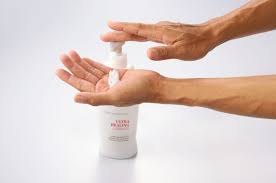
Treatment involves a combination of lifestyle changes, skincare practices, and, in some cases, medical interventions. Here are some effective treatment options:
- Moisturizing: Regularly apply a good quality moisturizer or emollient to the skin, especially after bathing and throughout the day as needed. Look for products containing ingredients like hyaluronic acid, glycerin, shea butter, or ceramides, which help to lock in moisture and improve skin hydration.
- Limit Bathing Time and Water Temperature: Avoid long, hot showers or baths, as they can strip the skin of its natural oils and exacerbate dryness. Instead, opt for lukewarm water and limit bathing time to no more than 10-15 minutes.
- Use Gentle Cleansers: Choose mild, fragrance-free cleansers or soap-free formulations that won’t strip the skin of its natural oils. Avoid harsh soaps or cleansers containing alcohol, fragrances, or other irritants that can further dry out the skin.
- Humidify the Air: Use a humidifier in your home, especially during the winter months when indoor air tends to be dry. A humidifier can add moisture to the air and help prevent skin from becoming too dry.
- Stay Hydrated: Drink plenty of water throughout the day to keep your body hydrated, which can help maintain skin moisture from within.
- Protect the Skin: Wear protective clothing, such as gloves and scarves, to shield the skin from harsh weather conditions like cold temperatures and wind. Use sunscreen to protect the skin from UV radiation when outdoors.
- Avoid Irritants: Limit exposure to known irritants such as harsh chemicals, detergents, perfumes, and allergens that can exacerbate dryness and irritation.
- Prescription Medications: In severe cases of skin or conditions like eczema or psoriasis, a dermatologist may prescribe topical corticosteroids, immunomodulators, or other medications to reduce inflammation and improve skin barrier function.
- Moisturizing Baths: Add colloidal oatmeal, bath oils, or other soothing ingredients to bathwater to help hydrate and soothe dry skin. Avoid using hot water and limit bathing time to prevent further moisture loss.
-
Lifestyle Modifications: Maintain a healthy lifestyle by eating a balanced diet rich in fruits, vegetables, and omega-3 fatty acids, which can help support skin health. Avoid smoking and limit alcohol consumption, as these habits can contribute to dryness and premature aging of the skin.
Cocoa

The natural chemicals in cocoa and dark chocolate products work to increase blood flow to the skin, thus increasing moisture
Cocoa butter is a natural fat that comes from the cocoa bean, and it is often used in skincare products to help moisturize and soothe dry skin. Cocoa butter contains fatty acids, which can help to hydrate and nourish the skin. It is also rich in antioxidants, which can help to protect the skin from environmental stressors that can cause dryness.
In addition to using skincare products that contain cocoa butter, consuming cocoa may also have benefits for dry skin. Research has shown that the flavanols in cocoa can improve skin hydration and increase blood flow to the skin, which can help to improve the appearance of dry, dull skin.
However, it is important to note that consuming large amounts of cocoa or chocolate may have negative effects on the skin and overall health due to the high sugar and fat content. It is best to consume cocoa in moderation and to use skincare products that contain cocoa butter or other beneficial ingredients to help treat and prevent symptoms.
Oatmeal
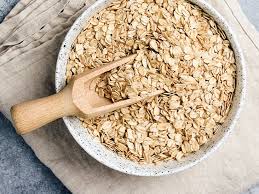
Oatmeal is a natural ingredient that can be very beneficial. It contains compounds called beta-glucans, which can help to soothe and moisturize the skin. Oatmeal is also a gentle exfoliant, which can help to remove dead skin cells and unclog pores. The oatmeal mask absorbs excess oil and dirt from the skin’s surface. It stimulates circulation, making the skin appear fresher.
One way to use oatmeal for dry skin is to make an oatmeal bath. Simply add one cup of colloidal oatmeal (finely ground oatmeal) to a warm bath and soak for 10-15 minutes. The oatmeal will help to soothe and moisturize dry, itchy skin.
Oatmeal can also be used as a natural face mask for dry skin. Simply mix one tablespoon of colloidal oatmeal with enough water to form a paste. Apply the paste to your face and let it sit for 10-15 minutes before rinsing off with warm water. This will help to hydrate and soothe dry, irritated skin.
It is important to note that some people may be allergic to oatmeal, so it is best to test a small patch of skin before using it all over your body. Additionally, it is important to choose plain, unsweetened oatmeal and avoid added ingredients like sugar or honey, which can be drying for the skin.
Oatmeal mask base
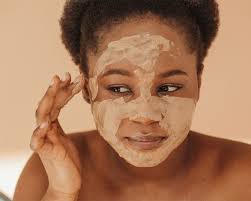
To prepare an oatmeal mask base, you will need:
- 1/4 cup of finely ground oatmeal (colloidal oatmeal is ideal)
- You can place a cup of oatmeal into a food processor or blender
- Enough warm water to create a paste
Instructions:
- Place the oatmeal in a small bowl.
- Gradually add warm water to the oatmeal, stirring until a thick paste forms.
- Continue stirring until the mixture is smooth and free of lumps.
To use the oatmeal mask:
- Start with clean, dry skin.
- Apply the oatmeal mask to your face using your fingertips or a soft brush, avoiding the eye area.
- Leave the mask on for 10-15 minutes.
- Rinse the mask off with warm water, using gentle circular motions to exfoliate your skin.
- Pat your face dry with a clean towel.
- Follow with your usual moisturizer or serum.
You can also add other natural ingredients to your oatmeal mask base, such as honey, yogurt, or mashed avocado, depending on your skin type and specific needs. Just be sure to do a patch test first to make sure you are not allergic to any of the ingredients.
Aloe
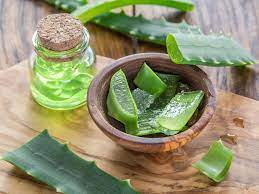
Aloe vera is a natural ingredient that has many benefits for dry skin. It has been used for centuries to soothe and hydrate skin, thanks to its high water content and a variety of vitamins and minerals that nourish the skin.
One of the main benefits of aloe vera for is its ability to hydrate and soothe. Aloe vera gel contains polysaccharides, which help to lock in moisture and keep the skin hydrated. It also has anti-inflammatory properties, which can help to reduce redness and inflammation associated with dry skin.
Aloe vera can be used in many different ways to treat dry skin. One way is to apply a small amount of pure aloe vera gel directly to the affected area. This can be done as often as needed to soothe and hydrate the skin.
Another way to use aloe vera for dry skin is to mix it with other natural ingredients to create a hydrating mask. For example, you can mix equal parts of aloe vera gel and honey to create a hydrating and nourishing face mask. Apply the mixture to your face and leave it on for 15-20 minutes before rinsing off with warm water.
Overall, aloe vera can be a great addition to any skin care routine. It is gentle, hydrating, and has many other beneficial properties that can help to soothe and nourish dry, irritated skin.
Uses of aloe
acne, bed sores, chapped skin, cuts and scrapes, dermatitis, eczema, poison oak and ivy, burns, ring worm, shingles, sunburn
Tricks to avoid scratching a dry and itchy skin
Scratching dry and itchy skin can provide temporary relief but may exacerbate the problem and lead to skin damage or infection. Here are some tricks to help avoid scratching and alleviate discomfort:
- Keep skin moisturized: Regularly apply a gentle, fragrance-free moisturizer to keep the skin hydrated and reduce itchiness.
- Cool compress: Apply a cool, damp cloth or ice pack to the itchy area to soothe irritation and reduce inflammation.
- Wear soft, breathable fabrics: Choose clothing made of cotton or other natural fibers that won’t irritate the skin and avoid tight-fitting garments.
- Trim nails: Keep nails short and smooth to minimize skin damage from scratching and reduce the risk of infection.
- Distraction techniques: Engage in activities that keep your hands busy and your mind off the itch, such as knitting, drawing, or listening to music.
- Moisturize before bed: Apply moisturizer before bedtime to help hydrate the skin overnight and reduce itching while you sleep.
- Use gentle skincare products: Choose mild, hypoallergenic cleansers and avoid products with harsh chemicals or fragrances that can irritate the skin.
- Avoid hot showers: Hot water can further dry out the skin and exacerbate itching, so opt for lukewarm showers or baths instead.
- Calming ingredients: Look for skincare products containing ingredients like oatmeal, aloe vera, or chamomile, which can help soothe dry, itchy skin.
- Seek professional help: If home remedies aren’t providing relief or if itching persists, consult a dermatologist for further evaluation and treatment options.
- Vinegar: Vinegar also provides moisture to the skin. Cover the affected area with a cloth soaked in vinegar. Leave in place for about 20 minutes to destroy any bacteria present on the skin. About 2 tablespoons or 2 cups of vinegar can be applied to a bath to provide itching relief.
- Take an oatmeal bath: Soaking in an oatmeal bath can help to soothe and moisturize dry, itchy skin. Add one cup of colloidal oatmeal to warm bathwater and soak for 10-15 minutes.
Remember, if your dry and itchy skin persists or is accompanied by other symptoms like rash or fever, it is best to see a dermatologist or healthcare provider for proper diagnosis and treatment.
When to seek urgent medical care for dry skin
While dry skin is a common and often manageable condition, certain symptoms may indicate a need for urgent medical attention. Here are situations where seeking urgent medical care is advisable:
- Severe Itching: If accompanied by severe itching that does not respond to over-the-counter remedies or home care measures, it could indicate an underlying skin condition such as eczema or psoriasis that requires medical evaluation and treatment.
- Signs of Infection: Dry skin that becomes cracked, bleeding, or shows signs of infection such as redness, swelling, warmth, or pus should be evaluated by a healthcare provider. Prompt treatment is essential to prevent complications and promote healing.
- Rapidly Spreading Rash: If accompanied by a rash that spreads rapidly or worsens in severity, it may indicate an allergic reaction, infection, or other underlying condition requiring medical attention.
- Painful Skin: Dry skin that causes pain, especially if it affects a large area of the body or is associated with other symptoms such as fever or malaise, may indicate a more serious underlying condition that requires medical evaluation.
- Systemic Symptoms: If accompanied by systemic symptoms such as fever, fatigue, joint pain, or difficulty breathing, it may indicate a systemic illness or allergic reaction that requires urgent medical care.
- Failure of Home Remedies: If symptoms do not improve with home remedies or over-the-counter treatments, it may be necessary to consult a healthcare provider for further evaluation and management.
-
Concerns About Skin Cancer: If dry, scaly patches persist or change in appearance, it is important to have them evaluated by a dermatologist to rule out skin cancer or other serious skin conditions.
Disclaimer: The information provided in this content is for general informational purposes only. It is not intended as medical or healthcare advice, diagnosis, or treatment. Always seek the advice of a qualified healthcare professional with any questions you may have regarding a medical condition or healthcare decisions.

